Saturday, February 13, 2021
It's Valentine's Day: riders also have the right to celebrate the emotional bond that exists between them and their equines. Seaver invites you to reflect on the relationship you have with your horse and gives you exercises to work on strengthening it. At the end of the article, an interview with Philippe Richarda teacher and specialist in ethological equitation, to give you a better understanding of the relationship between rider and horse.
Man and horses have been interacting since prehistoric times. When he discovered the horse's potential, a genuine interdependence was created. Horses have enabled man to :

For centuries, it has improved the comfort of our societies and contributed to their development.
From now on, this superb animal is intended for sport and leisure. This change in perception is accompanied by new key notions: well-being, health , love of the horse and performance. Seaver has responded to these needs by creating its monitoring tools for horse health and performance.
The horse has becomea rider's friend, a mirror of who we are and a companion you can't lie to. The term "couple" perfectly describes this relationship of sharing, affection and trust established within this duo.
Forming a couple with your horse means that a connection can be observed between you, both on foot and on horseback. This suggests that there's a complicity, a shared pleasure in being together, and that you have your own habits.
If we talk about connection or couple, 3 key notions are fundamental:

Beyond describing the harmony of a duo, this expression also suggests an equal contribution, a mutual sharing. So it's important to see the horse for what it is, and not to overlook its contribution to your relationship.
A horse is a living being. It has its own needs, more or less strong instincts, different moods and a unique personality. Some horses are more sensitive or feel a greater need for affection and friendship than others. Appreciate him as a being who is not fundamentally bad, and don't punish him unfairly. However, make sure he respects you. Respect the horse by accepting him for what he is, with his faults, qualities and needs. Your riding will be all the better for it.
Here are our tips for improving or maintaining a relationship of affection and trust with your horse.
![]() On foot
On foot
![]() On horseback
On horseback
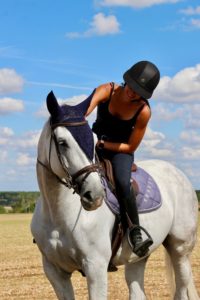
Like every person, every horse has a different personality. Some will be very close to humans, curious and "cuddly", while other horses will be less so. It's all a question of personality.
A horse that doesn't want to be petted can love you just as much as a horse that's a glue pot. He'll use a different language to show you his affection and respect.
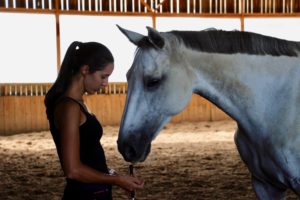
With horses, most communication takes place through body language. Instead of waiting for "human" signs of affection, take the time to observe his behavior towards you. This time, in horse language.
Horses are gregariousanimals . Inother words, they naturally live in groups. A horse naturally needs tosocialize with its fellow creatures.
In the natural environment, or even on pasture, horses establish a dominant relationship with each other.
Depending on their age and personality, each of them will have a well-defined role in the group. It's quite easy to determine each of these " social statuses " in horses by observing their behavior with other horses.
During your observations, you may notice that affectionate gestures such as "scratching" also exist in the herd. But a bond must first be created between horses, a bond of trust that must also be created with humans.
By spending time with your horse, you'll learn to live together. According to theICFE, "horses can recognize the human beings they know, both visually (even in photos) and by the sound of their voice."
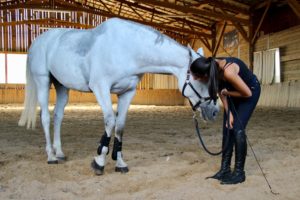
Horses have a good memory and will not behave in the same way with every rider they meet. The greatest sign of affection a horse can give you is his confidence.
You'll notice it by its relaxed, calm attitude. The horse will express his well-being and sense of security by following you around, head down and ears relaxed.
Philippe Richard is a teacher of classical equitation and a competition rider (cso, eventing, driving) who now bases his teaching on notions of ethology.
After learningclassical equitation and obtaining his monitorat and instructorat, Philippe Richard became French Teacher Champion in 2006.
As a competition rider, he focused a lot on the quest for performance, like any athlete, but sometimes to the point of forgetting the very basis of a good relationship between rider and horse. His relationship with his horses became more and more distant from the one he had originally aspired to, sidelined by high expectations of both himself and his horses.
This led him to lose faith in his profession and his status as ahorseman. From that moment on, he wanted to change his equitation and see things differently by getting closer to and training inethology, notably with Andy Booth.
So imbued with knowledge based on Horsemanshiphis relationship with competition and teaching changed completely. Today, his priorities are thephysical, mental and emotionalintegrity of the horse.
" Often, people call me because there's a difficulty in the relationship between an owner and their horse, so I can help them improve the connection between them. "
-
The foundations of a good relationship are the right balance between respect and trust between rider and horse, and the reciprocity of this balance.
Firstly, the rider must be able to trust his horse, and the horse must be able to trust his rider.
The second point is respect. As a rider, I must respect my horse physically, mentally and emotionally. In return, the horse has to respect who I am, which means respecting my personal space in the first instance, as well as the instructions I give him as my partner.
In my opinion, you can have a partner relationship with a horse, or a "slave" relationship. A good relationship is one in which you consider yourself to be a partner with the horse, on anequal footing. As a human, I have to take into account his needs and fears. He must respect my physical integrity, not pushing, kicking or biting me, for example.
Otherwise, if the horse is afraid of me, there's no good relationship either. The basis of a good relationship is the balance between respect and trust. Too much trust on the horse's part can lead to disrespect. You have to find the perfect balance between these two notions.
Of course, it's all the same, using the same foundations, if there's an excess of respect or confidence on the part of the horse, for example. As we've said, if a horse is overconfident, this can lead to a lack of respect, and conversely, if he's overrespectful, he can become so withdrawn that he fears me or runs away from me.
From the rider's point of view, he may generate too much energy or not enough. If he releases too much, he will induce excessive respect. Conversely, if the rider takes a back seat, or doesn't dare, the horse will gradually become overconfident. The result is incompatibility. It's time to rebalance.
From my point of view, this incompatibility is not irreversible, in the sense that if the rider works on himself, he can change things. The rider must adapt to the horse. This is the very basis of horsemanship. I choose to be a rider, I choose to enter into communication with the horse, it's up to me to learn to adjust my behavior and find out what's wrong and change things.
In concrete terms, the best thing to do in this case is to start by establishing a healthy connection by working freely in a round pen. This is the best way for the horse to express whatever it has to say (fear, disrespect), by running away for example.
So I'm not going to prevent it, but I'm going to try to control it. If a horse isn't looking for a connection, if he's looking outside the circle and not in my direction, he's telling me that he doesn't want to communicate with me, who's in the middle of the circle. I'll seek his attention, trust and respect by asking him to move.
Little by little, the horse begins to communicate with me. When I can get the horse to turn his inner ear in my direction, that's the first step. I ask the horse to turn in the circle, and the moment the horse shows the slightest interest in me, I release the pressure by stepping back, moving my feet back and assuming a low-energy posture that will bring comfort to the horse.
This way, I'll be almost facing the horse as he's close to the track, and he'll have two options. If he stops, faces me and looks at me, that's the right answer. If he doesn't, he's likely to run away, turn around and change hands, in which case I'll set the horse in motion again. This is how you establish a relationship. Over time, the horse will let the human approach, equip and train him.
Putting the horse in motion, "taking control of his feet" induces the kind of leadership behavior he might encounter with other horses.
In a herd, there's always a leader, whose presence will keep the others away or even initiate the herd's escape in the event of danger. While maintaining a balance between respect and trust, you need to take the lead when connecting with your horse. Taking control of the horse's feet, as a dominant horse would do in the wild, will enable me to guide the horse without coercing him.
If you want a good relationship with your horse, you have to be the leader, both on foot and mounted, to be able to guide him through an obstacle course or a dressage routine, for example, but also to make him feel reassured and safe.
Safety is a very important aspect of a horse's well-being. Even though we are not a horse, he will be reassured to find the hierarchy he can find in his natural environment, where every herd needs a leader, to warn the group of danger for example, or to provide comfort.
Please note: the fact that there is a leader does not imply that there is a master and a slave. A leader is simply an individual who proposes, if the horse is in good physical, mental and emotional condition, to perform an exercise while respecting its integrity.
I don't know if we can talk about love in the sense we understand it as humans. I don't think they have the same notion of emotions as we do, even if they do.
On the other hand, I'm convinced that some horses enjoy being with other horses and have a stronger affinity with certain members of the group. If a "friend" leaves the meadow and then returns, a horse's attitude or voice can express the joy of finding his horse companion.
I've seen some horses behave in the same way towards a human, as part of a solid relationship based on trust and respect. So yes, you can create a real bond between rider and horse.
To better understand the relationship we have with our horses, it's best to observe them behaving with other congeners, whether they like them or not, and compare the horse's behavior towards them with its behavior towards us.
Indeed, some horses, like humans for that matter, are more expressive or extroverted than others. They won't all show their feelings and emotions in the same way.
The best advice I can give a rider is: ask yourself questions, take the time to find out where the imbalance comes from if there is one, and how you can change your behavior to achieve a perfect balance between trust and respect, which are really the pillars of a good relationship between horse and rider. A real connection requires great humility on the part of the rider.
We'd like to thank Philippe Richard for this insightful interview on the precious horse-rider connection. If you'd like some help in building this connection, he travels all over France to give courses.
To visit the website and find out more: click here.
To contact him: equicompetition86@gmail.com / 06 16 54 02 25
As we all know, horses are fearful creatures. For them, anything outside their environment can be a threat, and their first response is to flee.
The aim of this exercise is first and foremost toaffirm the relationship of trust you share with your horse. Working on foot is a good way to vary your sessions and keep your horse's morale high. And don't forget that horse training is never finished. So, to ensure your safety and that of your horse, it's important to make him understand that the equipment you're working with, or umbrellas and other plastic bags, are not a threat to him.
This game can be played at several levels:
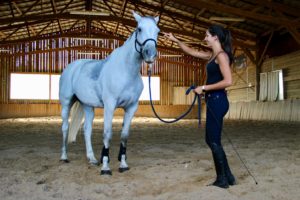
In this first stage, we want to check that your companion can be handled without fear or aggression. Simply equip your horse with a halter and lead rope and stroke him. Start with comfortable areas, then try to put your hand in his ears, tickle his withers, his belly and try to lift his tail. All these steps should be taken calmly. Don't let your horse try to run away or defend himself.
Tip: don't insist if your horse lets you touch his ears, for example, even for a few seconds: remove your hand to avoid rushing him. Gradually, he'll let you scratch him for longer. And above all, don't forget the reward.
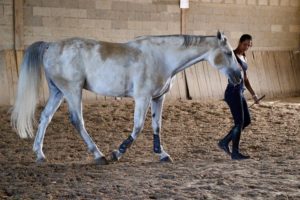
Start by gently touching him with the equipment on his shoulder, then gradually move over his back, his limbs, under his belly and finally to his ears. The aim here is to differentiate between the object and the command. Your horse must remain calm and relaxed, and not become frightened or aggressive. Once you've mastered the method with familiar equipment, repeat the experiment with an open umbrella, for example, or a garbage bag.

Let us explain: the horse now lets you handle him and scratch everywhere without fear. That's great! Now, whether on foot or on horseback, we may have to react quickly and make sudden gestures, it happens. That's whyyou need to get your horse used to it, and make him understand that you too are a living being. The aim here is to jump up beside your horse, make big gestures with your arms or legs beside your horse without making him worry.
Start by simply raising your arm in the air and lowering it again. Your horse should remain calm, not run away or raise his head suddenly. Once you've reached this stage, you can swing your arm next to him, then over his neck or under his belly. We're looking for immobility in the movement. Once you've mastered these steps, you can imagine several different situations and vary the exercises!

This final level is very similar to Level 3. Here, you're not invited to wave your hands, but to wave a piece of equipment, such as an umbrella. The material used in stage 2 is taken up a notch. Contact with the umbrella is accepted. Now look for calm and a relaxed horse when the umbrella opens beside him (avoid umbrellas that open very suddenly, start gently). You can vary the exercise. Flag a plastic bag over him, or shake your phone with music, for example.
Tip: the aim is not to trick or surprise the horse. We take care to warn him of the movement, to capture his attention during the exercise.
We hope you enjoyed this article.
To make sure you don't miss any of our news, follow us on our social networks: Instagram, Facebook, YouTube and LinkedIn.
Don't forget to share your experience in comments or on our networks!
Psst... We have a Valentine's Week offer until February 19. Please visit our website to find out.
See you soon on the Seaver blog.